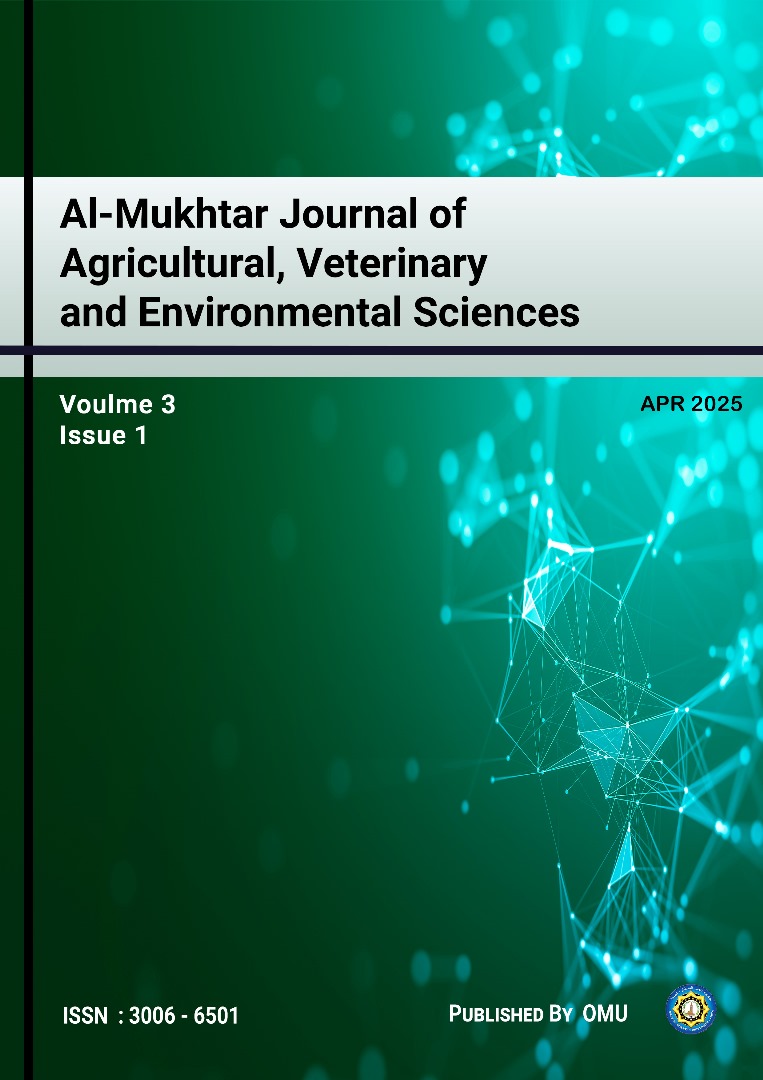The effect of compound mineral fertilizer (NPK) and Humic acid on the vegetative and flowering characteristics of Squash plants ( Cucurbita pepo L)
DOI:
https://doi.org/10.54172/ba863n63Keywords:
حمض الهيوميك, نبات الكوسا, تسميد, عضوي, معدنيAbstract
The study was conducted to determine the effect of combined mineral NPK and organic fertilization with humic acid on the vegetative and flowering characteristics of Squash plants. A field experiment was conducted during the 2020 and 2021 in Al Jabal Al Akhdar in the Al-Wasita area. A randomized complete block design split in three replications was used, as the experiment included 25 factorial treatments representing all possible combinations between the levels of the factors studied for both NPK complex. fertilizer (0, 45, 90, 135 and 180 kg/ha) and levels of humic fertilizer ( 0, 20, 40, 60 and 80 kg/ha. The results showed that the increase in the levels of mineral fertilizer led to significant differences in all the vegetative and floral traits response to the increase in the levels of NPK. The rate of 180 NPK kg/ha gave the highest values compared to the control treatment for all vegetative and floral traits The study showed that the increase in humic fertilizer rates from 0 kg/ha to 80 kg/ha was accompanied by a significant increase in vegetative growth and floral traits, The rate of 80 kg Humic/ha gave the highest significant values compared to the control treatment for all traits The results of the effect of the interaction between NPK and humic on the vegetative and floral traits indicated that there were clear significant differences, and that the best compatible treatment that gave the highest significant increase in both vegetative and floral traits was (180 NPK and 80 kg/ha humic.
References
Ahmed, Y.M.A. (1994). Effect of nitrogen fertilization level and postharvest treatments on storability of squash fruits. M. Sc. Thesis, Fac. Agric. Moshtohor, Zagazig Univ., Egypt.
AL-Jeboury, K. D. H.( 2010). Studying of the combining ability of developed summer squash genotype to potassium . Ph .Thesis ,Baghdad University ,Iraq. Akanbi., W.B.Togun.A.O., Adedirn. J.A and Ilupeju .Growth, Dry Matter and Fruit Yields Components of Okra under Organic and Inorganic Sources of Nutrients. American-Eurasian Journal of Sustainable Agriculture, 4(1), 2010, 1-13.
AL-Mukhtar ,F. A. , F. M Hummdi and F. H. AL-Sahaf.(1988). Effect of different levels of NPK fertilizer on growth and yield of two summer squash cultivars .Acta Hort. 220: 253- 256.
Anonymous.(2005). Humic Acid, Organic Plant Food and Root Growth Promoters. An Erth Friendly (ecochem) 17/2/2007. File: G: humic acid. -A.O.A.C. 1992. Official Methods of Analysis Association of Official Analytical Chemists. Washington D.C., USA. 139p. (12th Ed).
Bahuguna, R. N., Chaturvedi, A. K., Pal, M., Viswanathan, C., Jagadish, S. K., & Pareek, A. (2022). Carbon dioxide responsiveness mitigates rice yield loss under high night temperature. Plant Physiology, 188(1), 285-300.
Bayu, W., N.F.G. Rethman, P.S. Hammes and G. Alemu. (2006). Effects of farmyard manure and inorganic fertilizers on Sorghum growth, yield and nitrogen use in a semi-arid area of Ethiopia. J. Plant Nutrition., 29(2): 391-407.
Black, C.A. 1965. Methods of soil analysis. Amer Soc. Agron. Madison, Wi., U. S. A.
Chailakhyan, M.KH. and V.N. Khrianin . (1987). Sexuality in Plants and Its Hormonal Regulation. Moscow, Translated, SpringerVerlag, USA.pp:155.
Chen, Y., & Aviad, T. (1990). Effects of humic substances on plant growth. Humic substances in soil and crop sciences: Selected readings, 161-186.
FAO. (2020). https://www.fao.org/faostat/en/#data /QCL (CITIED ON 13-7-2022
Gomez, K. A., & Gomez, A. A. (1984). Statistical procedures for agricultural research: John wiley & sons. J. Agril. Res50(3): 357-364.
Grazia ,J. D. , P. A. Tihonell , O. S. Pernida , A. Caruso and A. Chiesa . (2005) . Evaluation of crops setting systems for four summer squash varieties (Cucurbita maxima L.) Millan Var. Zapallito. Agriculture Technical (Chile) , 65(2): 127-134.
Jahan, M. and M Jahani . (2007). The effect of chemical and organic fertilization on Saffron flowering . Acta Hort. (ISHS) 793 : 81-86.
Lorenz ,O.A and D.N.Maynard .(1980). Knott’s handbook for vegetable growers . (2nd ed.). Wiley Interscience N.Y.390pp.
Lützow, M.V., Kögel‐Knabner, I., Ekschmitt, K., Matzner, E., Guggenberger, G., Marschner, B. and Flessa, H.(2006). Stabilization of organic matter in temperate soils: mechanisms and their relevance under different soil conditions–a review. European journal of soil science, 57(4), pp.426-445.
Manjunath ,C. T. , A. S. Sijjan , B. S. Vyakaranahal , H. L. Nadaf and R. M. Hosamani . (2008). Influence of nutrition and growth regulators on fruit , seed yield and quality of pumpkin cv. Arka. Karnataka J. Agric. Sci. 21(1(:115-117).
Marschner, H. (1986). Mineral in higher plants. Academic press, Harcout. Brace Jovanovish Publisher, London.(1st ed).
Mbhele Z., Zobolo A. M., Ntuli, N.R. (2017). The effect of fertilizer on growth and yield of Cucurbita argyrosperma. South African Association of Botanists, University of the Western Cape, Cape Town, 08 - 12 January 2017.
Mengel, K., Kirkby, E. A., Kosegarten, H., & Appel, T. (2001). Plant growth and crop production. Principles of Plant Nutrition, 243-335.
Oloyede, F. M., Agbaje, G. O., & Obisesan, I. O. (2013). Analysis of pumpkin (Cucurbita pepo Linn L.) biomass yield and its components as affected by nitrogen,
Palm, C.A., R.J.K. Myers, S.M. Nandwa, (1997). Combined use of organic and inorganic nutrient sources for soil fertility maintenance and replenishment In Buresh R.J., Sanchez, D.A., Calhoun F (eds.) Replenishing Soil Fertility in Africa. Soil Science Society of America Madison, Wis., pp: 193-217.
Pessarakli, M. (2016). Handbook of Cucurbits: Growth, Cultural Practices, and Physiology. CRC Press. USA. pp:561.
Pettit, R. E. (2004). Organic matter, humus, humate, humic acid, fulvic acid and humin: their importance in soil fertility and plant health. CTI Research, 10, 1-7
Radiya, K.S.(2002).Effect of plant population, biofertilizesr and nitrogen on growth , fruit yield, seed production and seed quality of squash (Cucurbita pepo L .). Ph.D.Thesis , Fac. of Agric . Alex .Univ. Egypt.
Senn, T.L. and Kingman, A.R. (1973). A review of humic acid research series, No. 145, C. Agricultural Experiment Station, Clemson, South Carolina.Physiology. CRC Press. USA. pp:561
Taiz, L. and Zeiger, E.(2003). Plant Physiology. 3rded. Sinauer Associates, Inc. publisher Sunderland, Massachuts U.S.A.
Thompson, H. C and W. C. Kelly.( 1983). Vegetable Crops. Mc-Graw Hill Book Company, Inc., New York, U.S.A.
Uka, U. N., Chukwuka, K. S., & Iwuagwu, M. (2013). Relative effect of organic and inorganic fertilizers on the growth of okra [Abelmoschus esculentus (L.) Moench]. Journal of Agricultural Sciences, Belgrade, 58(3), 159-166 .
Whitaker , T. W. and G. N. Daves. (1962) . Cucurbits .InterScience Pup. ,Inc. N.Y.P:249.
Downloads
Published
Issue
Section
License
Copyright (c) 2025 Hasan Bendres Albaba , Fatma. Muhammad , Abdella Ateq (Author)

This work is licensed under a Creative Commons Attribution-NonCommercial 4.0 International License.













